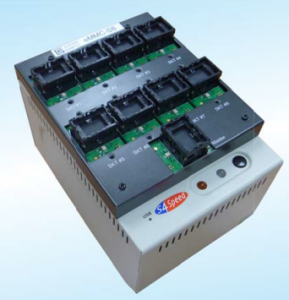Features
- Supports eMMC spec. versions: v4.3, v4.4, v4.41, v4.5, v5.0 and v5.1
- Supports Smart Mode, Partition Mode and Clone Mode
- Supports Chip Erase and Quick Erase
- Supports 3.3V, 1.8V & 1.2V eMMC devices
- Supports System General eMMC Image Builder
- Windows software interface and available “Job Control” functions
- Real-time statistics displays
- Friendly user interface
- Programming speed up to 36MB per second
- Allows being chained up to 20 programmer sites via USB ports for manual operations; automated operations available on System General Handlers
- Gang-programs up to 8 eMMC devices on each programmer site
- Socket cards hot-swappable for different package types without re-starting the programming system
- High-speed Slave duplications through the Master eMMC or download Image File from PC to Master memory board (V3) for programming
- Flexible software architecture designed to accommodate custom application requirements
- Universal programmer to support eMMC and other device technologies (ex: ERPOM, EEPROM, NOR Flash, NAND Flash, EEPROM, CPLD, MPU) under a single programming platform
further information
eMMC-S8 is a socket board designed to duplicate eMMC devices under the T9100 dedicated platform! The socket board is made of one Master socket card and up to 8 Slave socket cards, and is able to perform high-speed copy and verification from Master to blank Slaves. In case the Master is not available and customers have to rely on “Image Files”, an eMMC “Image Builder” software from System General will assist customers on converting the files into a System General custom format. The converted format file is then programmed into a blank MicroSD by using the available MicroSD Card Writer to generate the Master MicroSD. The eMMC–S8 socket board allows customers to use either Master eMMC or Master MicroSD to duplicate eMMC Slaves. Alternatively, the file can be directly transferred via USB3.0 interface.
Although the eMMC software architecture was designed to accommodate custom application requirements, most applications follow the eMMC specifications and the following three programming modes will meet customers’ standard eMMC application needs:
Smart Mode
The system starts up by scanning though the Master eMMC and logging those non-blank areas on a system-created “Scan Table”. Once Slave duplications are executed, the system will follow the Scan Table to do Copy/Verify from Master to blank Slaves.
Partition Mode
The system will follow the scanned “Partition Table” in the Master eMMC to execute Copy/Verify on blank Slaves.
Clone Mode
The system will copy/verify the Master to blank Slaves from the beginning address to the ending address, regardless of the data pattern in the Master.




